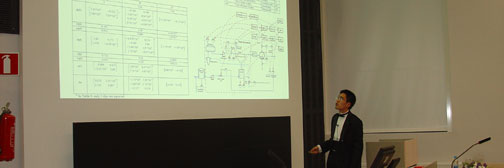| | Year 2016
Igor Saavedra SalasModel-based Optimization of a Compactcooking G2 Digesting Process Stage
A CompactCooking™ G2 (Valmet) digesting system represents a challenging process stage to be optimized in the context of a kraft pulp mill. Its highly non-linear behavior due to liquor recycling and heat integration poses a barrier to traditional trial-and-error optimization conducted by physical lab-scale simulation. Hence, this thesis aims to design a solution based on numerical simulation and mathematical optimization, whose results can be directly applied on industrial-scale as computed optimal set-points for the supervisory control.
Based on published, first-principles, pulp digester models, a customized dynamic model was developed in Matlab/Simulink to simulate a complete CompactCooking™ G2 stage. The process model is founded on Purdue wood reaction kinetics and Härkönen chips bed compaction models, and it seamlessly takes into account process characteristics mentioned above. The non-linear model was validated by comparison against historical data of an industrial unit (200 h), and then employed in the design of a steady-state optimizer for this process stage by means of linear programming.
Simulation results showed very good agreement in terms of liquors residual alkali, weak black liquor solids, and blowline kappa, despite high uncertainty on disturbances data and model simplifications. However, simulated kappa showed higher sensitivity to temperature fluctuations than the plant signal, likely indicating the need for more detail when modelling heat transfer phenomena. As to the optimization goal, a base case scenario (plant steady-state) was identified from industrial data to attempt process economics optimization. The results showed a potential for increasing profit or reducing variable costs in at least 2 USD/ADt, which for a modern pulp mill represents annual benefits between 1 – 2 million USD depending on production rate and mill availability.
Further, the simulation model showed remarkable results when used in a novel process analysis technique, called here simulated contribution, letting to explain the variability of blowline kappa in terms of multiple-time-scale process dynamics.
In conclusion, a model-based optimization method has been successfully designed for the CompactCooking™ G2 system, and potential economic benefits should encourage industrial testing and further work to develop a real-time optimizer software technology.
Thesis electronical version can be downloaded from here
This info last modified 27 Apr 2024 by Jukka Kortela
|

